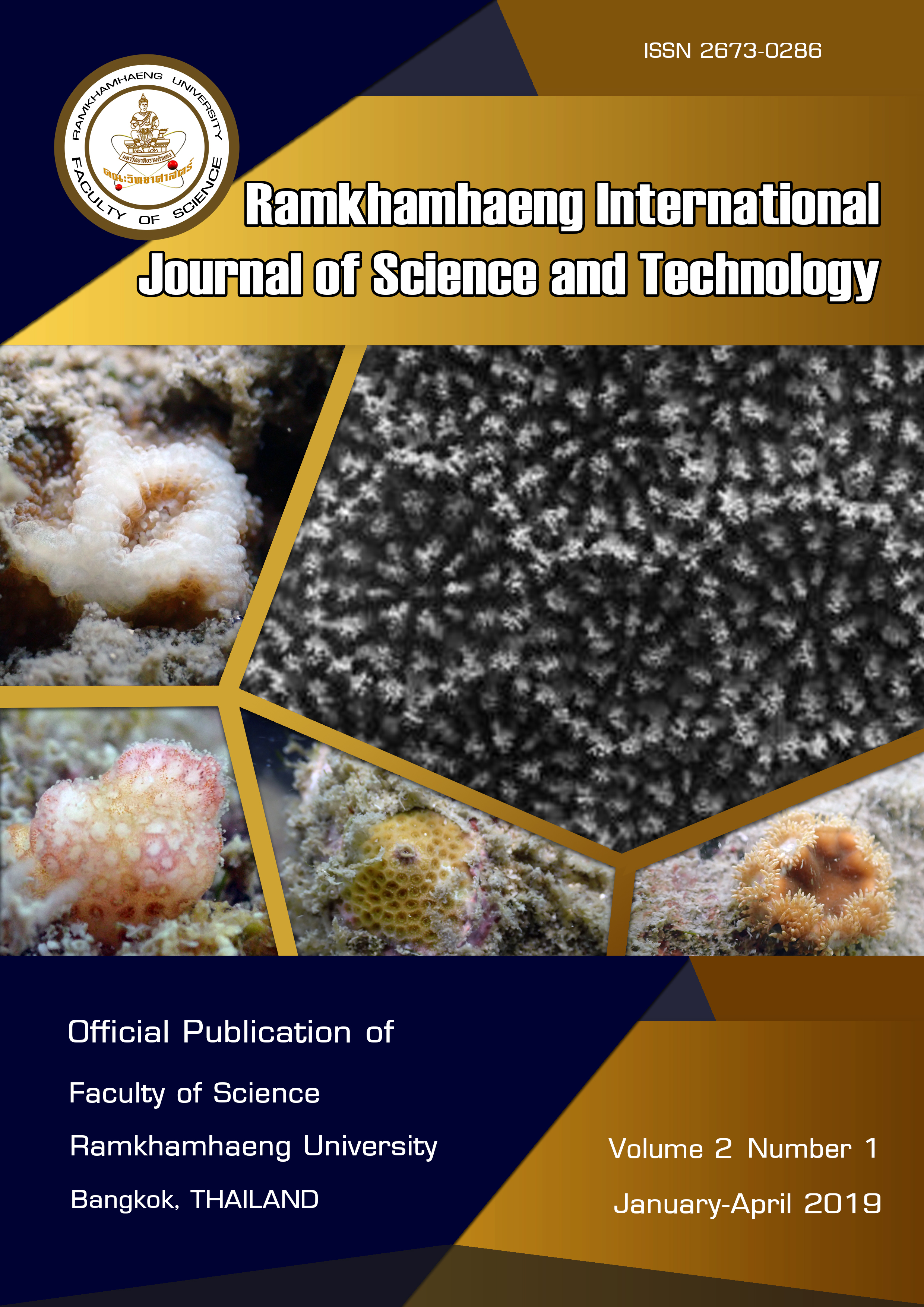Assessing population densities of Pocillopora acuta on shallow reef flats in the Western Gulf of Thailand
Keywords:
reef flat, distribution, Pocillopora acuta, Gulf of ThailandAbstract
Shallow reef flats are under extreme conditions with exposed light and high seawater temperature. The scleractinian coral Pocillopora acuta is one of the most abundant corals and widely distributes in the Indo-Pacific. The coral P. acuta is adapted to environmental changes and can survive under physiologically stressed that make them suitable to use in coral restoration projects. Therefore, this study aimed to assess the population densities of P. acuta on shallow reef flats in the Western Gulf of Thailand. The live coral P. acuta cover was determined by using permanent-belt transects, and the size of P. acuta was recorded. This study was conducted in 2018. The results revealed that the highest abundance of P. acuta was found at Ko Sam Sao (West) (12.38±1.53%) and Hat Mae Hadd (12.32±1.53%), which was significantly different from other study sites. In addition, Ko Phangan also showed high abundance of P. acuta. Most colonies of P. acuta were in a size class 15-30 cm, which are suitable to be breeders or fragmentation for the coral restoration project. This study provides important data of P. acuta distribution and abundance that can be applied to coral restoration and conservation in Thailand
References
Chou LM, Quek ST (2019) Planulation in the scleractinian coral Pocillopora damicornis in Singapore waters. Proceedings of the 7th International Coral Reef Symposium 1:500
English S, Wilkinson C, Baker V (1987) Survey manual for tropical marine resources. Australian Institute of Marine Science, Townsville, p 390
Glynn PW, Deweerdt WH (1991) Elimination of 2 reef-building hydrocorals following the 1982-83 el-nino warming event. Science 253:69-71
Hoegh-Guldberg O, Mumby PJ, Hooten AJ, Steneck RS, Greenfield P, Gomez E, Knowlton N (2007) Coral reefs under rapid climate change and ocean acidification. Science 318(5857):1737-1742
Hoegh-Guldberg O, Poloczanska ES, Skirving W, Dove S (2017) Coral reef ecosystems under climate change and ocean acidification. Frontiers in Marine Science 4:158
Hughes TP, Barnes ML, Bellwood DR, Cinner JE, Cumming GS, Jackson JB, Palumbi SR (2017) Coral reefs in the Anthropocene. Nature 546(7656):82-90
Kerr AM, Baird AH, Hughes TP (2011) Correlated evolution of sex and reproductive mode in corals (Anthozoa: Scleractinia). Proceedings of the Royal Society B-Biological Sciences 278(1702):75-81
Lee AC, Sin TM (2009) Trapezia septata Dana, 1852 (Brachyura, Trapeziidae): a new record for Singapore with notes on its relationship with the host coral, Pocillopora verrucosa. Crustaceana 82(12):1603-1608
Mace GM (2004) The role of taxonomy in species conservation. Philosophical Transactions of the Royal Society B: Biological Sciences 359(1444):711-719
Mimura N (2013) Sea-level rise caused by climate change and its implications for society. Proceedings of the Japan Academy, Series B 89(7):281-301
Nakajima Y, Chuang PS, Ueda N, Mitarai S (2018) First evidence of asexual recruitment of Pocillopora acuta in Okinawa Island using genotypic identification. PeerJ 6:e5915
Ng CSL, Toh TC, Chou LM (2016) Coral restoration in Singapore’s sediment-challenged sea. Regional Studies in Marine Science 8:422-429
Pandolfi JM, Connolly SR, Marshall DJ, Cohen AL (2011) Projecting coral reef futures under global warming and ocean acidification. Science 333(6041):418-422
Pengsakun S, Sutthacheep M, Yeemin T (2012) Comparing recruitment of Pocillopora damicornis affected by the 2010 bleaching event. Proceedings of 12th International Coral Reef Symposium. Cairns, Australia, p 4
Pinzón JH, Sampayo E, Cox E, Chauka LJ, Chen CA, Voolstra CR, LaJeunesse TC (2013) Blind to morphology: genetics identifies several widespread ecologically common species and few endemics among Indo-Pacific cauliflower corals (Pocillopora, Scleractinia). Journal of Biogeography 40:1595-1608
Poquita-Du RC, Ng CSL, Loo JB, Afiq-Rosli L, Tay YC, Todd PA, Chou LM, Huang D (2017) New evidence shows that Pocillopora ‘damicornis-like’ corals in Singapore are actually Pocillopora acuta (Scleractinia: Pocilloporidae). Biodiversity Data Journal 5
Schmidt-Roach S, Miller KJ, Lundgren P, Andreakis N (2014) With eyes wide open: a revision of species within and closely related to the Pocillopora damicornis species complex (Scleractinia; Pocilloporidae) using morphology and genetics. Zoological Journal of the Linnean Society 170(1):1-33
Toh KB, Ng CSL, Wu B, Toh TC, Cheo PR, Tun K, Chou LM (2017) Spatial variability of epibiotic assemblages on marina pontoons in Singapore. Urban Ecosystems. 20: 183-197
Toh TC, Peh JWK, Chou LM (2013) Heterotrophy in recruits of the scleractinian coral Pocillopora damicornis. Marine and Freshwater Behaviour and Physiology 46(5):313-320
Wheeler QD (2004) Taxonomic triage and the poverty of phylogeny. Philosophical Transactions of the Royal Society B: Biological Sciences 359 (1444):571-583
Yeoh SR, Dai CF (2010) The production of sexual and asexual larvae within single broods of the scleractinian coral, Pocillopora damicornis. Marine Biology 157:351-359
Downloads
Published
Issue
Section
License
Copyright Notice: a copyright on any article in the published journal is retained by the Ramkhamhaeng International Journal of Science and Technology. Readers or Users grant the right to use of the Article contained in the Content in accordance with the Creative Commons CC BY-NC-ND license and the Data contained in the Content in accordance with the Creative Commons CC BY-NC-ND.



